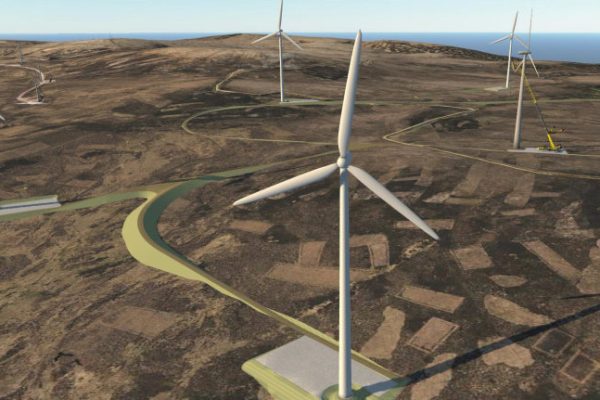
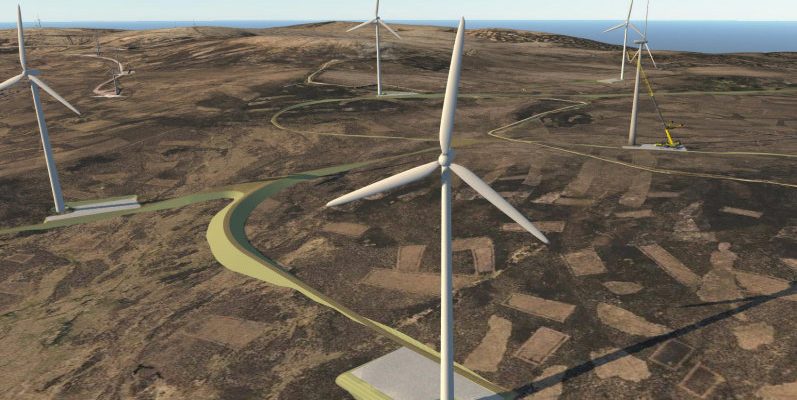
Green Cat Renewables (GCR) provided Pre-Construction Due Diligence, Technical Advisory Services and Energy Yield Assessments for a 69MW Wind Farm in Dumfries and Galloway.
Initial Technical Due Diligence was carried out to support project acquisition and included identification of technical risks relating to planning consent, grid connection, wind resource, ground conditions, transport, site layout, and costing information.
GCR also provided Technical Advisory Services in relation to turbine selection and undertook Energy Yield Assessments for multiple wind farm scenarios including turbines from suppliers such as Nordex, Vestas, and Siemens Gamesa. Modelled scenarios were based on the consented tip height with further assessments undertaken considering scenarios with a higher tip height due to a trend being identified in increased tip height consents of neighbouring wind farms.
Due to the complex nature of the terrain, a Computation Flow Dynamics (CFD) model was utilised to produce a more accurate Wind Resource Assessment.
A site visit was undertaken to confirm buildability and inform the review of the site layout. Following the site visit, alternative access routes required investigation due to the steep terrain, soft ground, significant watercourse crossing, and tight turning radii of the initial construction access track.
The grid element involved a Bilateral Connection Agreement and Construction Agreement review due to the 132kV transmission connection and consideration of the project’s participation in a General Export Management Scheme (GEMS).
Recommendations were made on anticipated downtime due to Category 1 intertripping in regard to reduction in yield.
To further inform the acquisition bid, GCR generated a CapEx and OpEx budget including construction costs, life cycle costs, grid connection costs, radar mitigation scheme, and the cost of ongoing maintenance and operation of the wind farm.


In 2013, Green Cat Renewable Developments Limited (GCRD) entered into a joint venture to develop the Aldercombe Barton Wind Project. The initial intention was for this to be a 4 turbine development, however after a consultation process with the Local Planning Authority and local residents it was decided that a single turbine development was more likely to gain consent. The heavily loaded nature of the local grid also leant itself to a smaller development.
With our in house expertise, we successfully developed a good working relationship with the local DNO, and negotiated a novel grid solution whereby the output from the turbine is restricted during peak hours in the summer months when local solar farms are exporting
at or near maximum output. This brought forward the connection date by several years and significantly reduced the connection cost, allowing the project to proceed through the development stage to construction.
The on-site electrical works were carried out by Green Cat Renewables’ sister company, Prelec Lmited.
The civil balance of plant works were carried out in house by Green Cat Renewables’ contracting arm, Green Cat Contracting (GCC).
Green Cat’s Geotechnical Team provided data for the detailed design phase, following their extensive ground investigation work.
This project came in on time and budget and has been operating successfully since July 2015 . It is a great example of the benefits to our clients that the vertical integration of the various companies, under the Green Cat umbrella, can deliver. Crucially it allows us to effectively reduce a project’s cost while dealing with unique challenges that these projects throw up.


The Benlister Hydro Scheme is located on the Benlister Burn on the Isle of Arran. The scheme lies within the Arran Moors Special Protection Area (SPA).
Green Cat Renewables provided post planning management, detailed scheme design, technical procurement services and Client’s Engineer services.
The key elements of this project are:
INTAKE STRUCTURES
The scheme has 2 intakes which divert water to a main collection intake where the pressurised pipeline starts.
PENSTOCK
The aqueduct pipelines are a total of 675m in length. The pipeline from the main intake to powerhouse is 3,125m long. The upper, low pressure section is of HPPE and the lower, higher pressure section ductile iron (DI). The pipeline has an above ground, pipe bridge, where it crosses the Tounie Burn.
POWERHOUSE
The powerhouse is designed to be a steel portal frame with concrete block infill. Planning conditions required that the roof is covered with grey profiled tin and external walls are clad with vertical larch timbers. The acoustic doors will ensure that sound emissions are kept to a minimum.
ACCESS
An access track used during construction will continue to provide access for maintenance. Its reinstatement to a vegetated running surface will substantially reduce the long term environmental and visual impact of the scheme.
CONSTRAINTS
The construction phase successfully incorporated seasonal working restrictions in relation to Hen Harrier’s in the area.
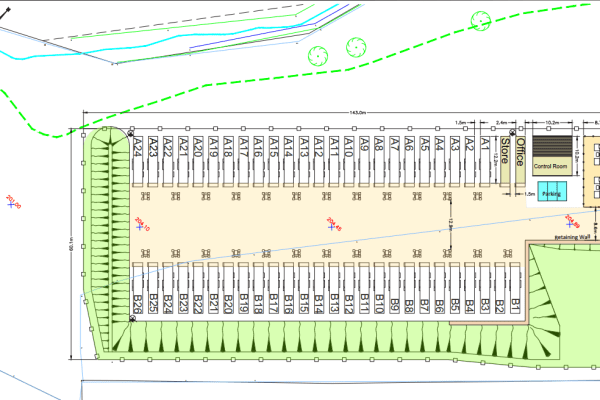
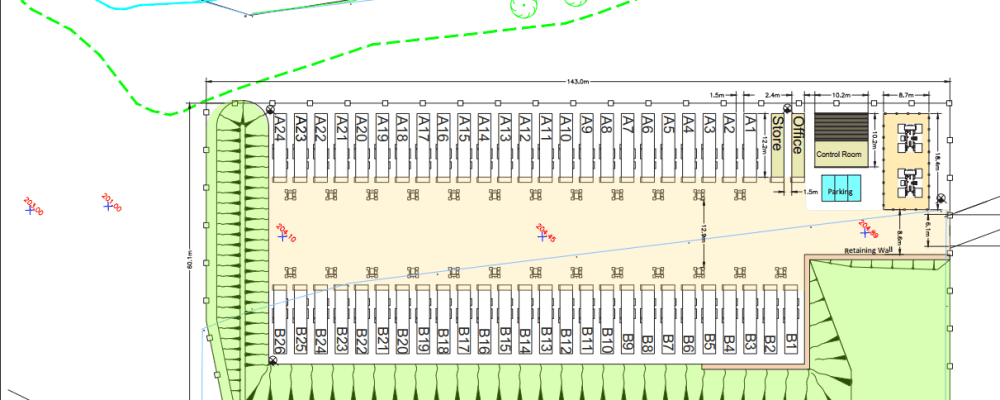
The 49.9MW battery energy storage facility (BESS) is located 1km east of Boat of Garten, in the Scottish Highlands. Green Cat Renewables (GCR) was engaged as environmental consultants for the development to provide technical assessments for the planning submission of the project.
As the appointed noise consultants for the project, GCR undertook a background noise survey at two locations near the development site. The data was then used to inform the noise impact assessment following BS4142:2014+A1:2019 guidelines. Attended measurements were also taken for the adjacent substation, to inform the cumulative noise assessment.
The development was represented in noise modelling software to predict the operational noise levels at nearby residential receptors. The assessment found that noise levels at one receptor may lead to adverse impacts and mitigation in the form of an acoustic barrier was proposed.
Once appropriate mitigation was incorporated into the noise model, the development immission levels were predicted to meet the required noise limits at all assessment locations.
The NIA also included a construction noise assessment following BS5228- 1:2009+A1:2014.
Following the successful submission, and consent of the development, GCR also provided support for discharge of conditions and engaged in detailed consultation with Environmental Health to agree suitable noise conditions. The amended conditions offered noise limits to protect the amenity of residents without putting undue constraint on the operation of the development. The amended conditions were approved in December 2023.
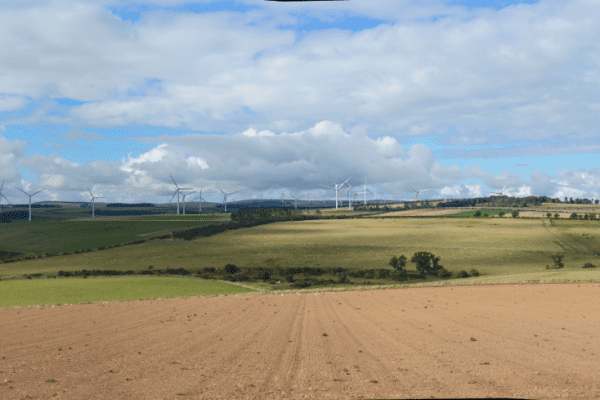
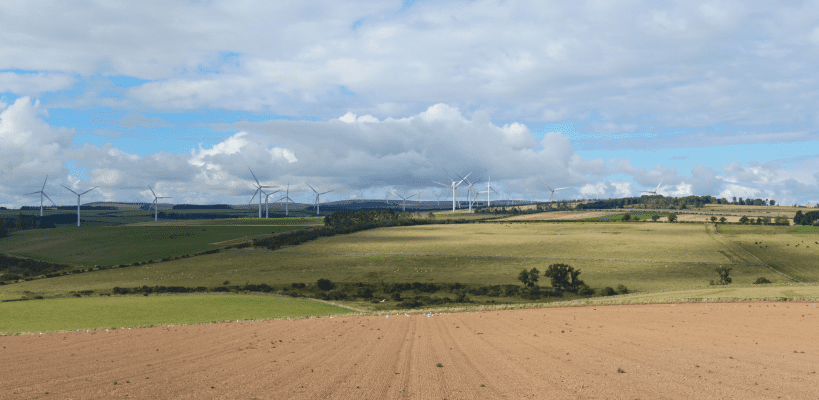
Blackburn Wind Farm is located approximately 2.5km west of Grantshouse in the Scottish Borders. Green Cat Renewables (GCR) was engaged as lead planning and environmental consultant, developing the project from initial design concept and feasibility, through the EIA process to obtain planning consent.
The final layout and turbine selection was the result of an extensive and diligent design process, which aimed to strike the optimum balance between minimizing environmental impacts, respecting engineering requirements and ensuring a viable scheme in a subsidy free environment. The key design principles behind the proposed scheme aimed to:
GCR worked closely with the Scottish Borders Council as the Planning Authority and key consultees in delivery of the project. Pre-application advice was incorporated into the final project design which led to a successful planning outcome.
One of the key considerations during early-stage design and consultation was the potential impact on the landscape. GCR carefully designed the scheme in order to fit within the same section of landscape character as the neighbouring, operational, Quixwood Wind Farm and appear as a cohesive extension.
The planning application was submitted in July 2023 and following a positive recommendation, through continued and open dialogue with Scottish Borders Council and key stakeholders, the application was approved under delegated powers in April 2024.


Green Cat Renewables, (GCR) was appointed as wind resource consultants with a view to providing a bankable assessment for the energy generation potential of the site.
The original consent for the development consisted of 3 2.5MW wind turbines, with a tip height of up to 100m.
The initial layout was designed on the basis of a turbine model that had become obsolete, thus GCR considered three alternative compliant models from various manufacturers as requested by the client, each with identical 2MW capacity and dimensions.
In addition to this, a fourth model identified and suggested by GCR was included in the assessment, with a higher 2.3MW capacity.
Whilst this model had a marginally larger rotor diameter, and increase on wake losses, the higher yield benefits outweighed the increased capital costs.
A comprehensive wind resource model of the site was developed based on metrological mast. As well as wind data, the model incorporated terrain data and neighbouring operational and consented wind projects.
OUTCOMES
The results provided by GCR enabled the client to progress to discussions with the local planning authority and the turbine manufacturers.
The estimated yield figures were used by the client as part of project cost models, allowing the client to select the most profitable scheme under the current consent.
The project progressed with a 2.3MW wind turbine. This delivered an improved capacity factor of around 31%, compared to around 27 – 28% for the other models.
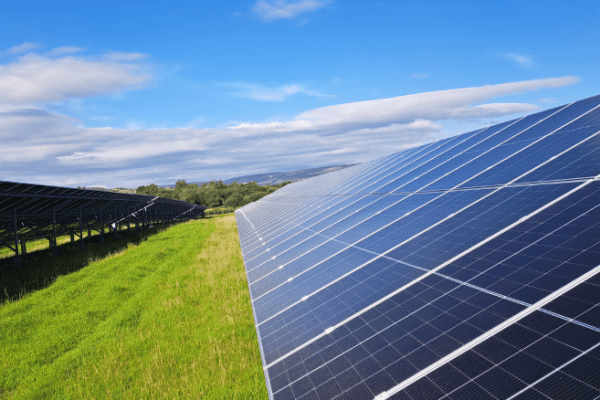
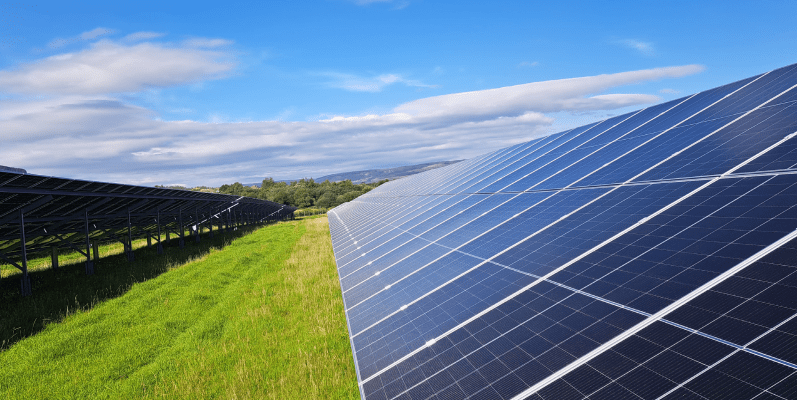
Green Cat Renewables (GCR) provided Pre-Construction Due Diligence, Technical Advisory Services throughout construction, and post-construction performance testing sign-off for two ground mount solar arrays. The two sites total 46MWp.
Pre-construction Technical Due Diligence was carried out to support project financing, including identification of technical risks relating to planning consent, ground conditions, a review of system configuration, EPC Contracts, O&M Contacts and Grid Connection Offers.
Following pre-construction Due Diligence, GCR were appointed to act as Client’s Engineer during the construction of each array. This involved general project and contract management, as well as construction supervision.
Site visits were conducted by GCR at relevant EPC Contract Milestones and Milestone sign-off reports were provided to the Developer. Site visits monitored construction progress, installation methodology, site condition, and quality of the installations.
Recommendations were made following site visits and incorporated into punch lists.
Although the two sites were built-out by the same contractor under the same developer, each site has specific issues to consider. The varying topography at each site had impacts on array configuration such as inter-row spacing and inclination angle, as well as issues during construction such as access for delivery of components and site drainage. These constraints were considered during the initial Due Diligence process and during construction site visits.
Following substantial completion of construction, GCR conducted a Provisional Acceptance (PAC) site visit to enable PAC sign off and to feed into the final punch list to identify all outstanding snagging items. A review was then conducted of the Contractors Performance Ratio (PR) calculation to verify methodology and adherence to the EPC Contract.


Burton Wold South is a three turbine development just south of an existing operational wind farm at Burton Latimer and a second wind farm Burton Wold North.
Infinergy developed the site and secured planning consent in 2014.
The site is being developed by BWWFS Ltd, which is a partnership 2015 between Infinergy, WWS and Muirhall Energy . The Developer appointed GCR as Client Engineer, which entailed the roles of FIDIC Project Manager and CDM Principal Designer.
The site is on arable farmland and is accessed via an upgraded farm track from the A6 adjacent to Burton Latimer.
A Design and Build Contract was awarded to AE Yates for the Balance of Plant works. Close co-ordination was required to manage this interface with the DNO, Western Power Distribution and turbine installation contractor, General Electric.
GCR managed the route access interface through Roxhill Development Construction site involving adjacent realignment of A6/A14 junction, and installation of three new roundabouts.
Close liaison with Western Power Distribution (DNO) was key to the successful delivery of this project within the Ofgem ROCS deadline of March 2017.


Corrimony wind farm is a 5 turbine development at Glenurquhart, near Drumnadrochit and Glen Affric in Highland Region.
At 11,500kW the five Enercon E70’s with a 100m to tip height project was consented in 2010.
Green Cat Renewables (GCR) assisted the Client in 2012 to discharge planning conditions, award contracts and supervise the construction.
GCR acted as the Client’s Engineer, to manage the interface between the turbine erection, Balance of Plant contract and grid connection. The role of CDM Planning Supervisor was also included to ensure compliance with CDM Regulations 2015.
The site is located on elevated peaty moorland adjacent to Glen Affric and an RSPB Nature Reserve so required additional input to ensure that environmental constraints were met.
Green Cat Geotechnical department undertook a detailed site investigation.
This included peat survey and peat risk slide assessment and management of disturbed peat.
Tenders and three separate contracts for hard standings, turbine erection and grid connection were coordinated and managed.
Grid – this involved 7.5km of ICP grid connection to SSE Grid substation at Fasnakyle.
To achieve the March 2013 Ofgem ROC deadline it was necessary for GCR to actively co-ordinate actions of all the parties involved.


In 2013, Green Cat Renewables Limited (GCR) started work on the planning for this single turbine project.
This is a very constrained site and was only possible by agreeing that normal noise limits at the clients own home could go beyond standard limits even for a financially interested property. This involved putting in place legal documents to ensure the turbine always stayed in the same ownership as the affected house. These agreements caused some unique challenges to the funding of the project as did clients requirement to minimise equity.
Working with the developer and the bank Close Brothers, GCR managed to help negotiate the finance for the project and structure finance terms that allowed the project to proceed.
This project came in on time and budget. The project has been successfully operating since September 2015.


In 2016, Green Cat Renewable Developments Limited (GCRD) purchased the Deuchries Wind Farm project after the previous owner decided the project was no longer viable due to reducing subsidies, complex grid restrictions and challenging site conditions.
With Green Cat Renewables’ in-house expertise and good working relationships with the local DNO, a more economical grid solution was obtained allowing the project to proceed through the development stage to construction. The on-site electrical works and the ICP contestable works were carried out by Green Cat Renewables’ sister company, Prelec Limited. Their scope of works included just under 3km of underground cabling and an on-site 33kV substation.
The challenging site conditions with extensive cut and fill was undertaken by Green Cat Contracting (GCC), who were able to carry the works out efficiently and economically. One of the first tasks for GCC was to establish two on-site borrow pits to provide the large quantities of fill material required to form the access tracks and crane hardstandings.
Green Cat Renewables were able to provide detailed site design to GCC using data obtained from extensive ground investigation work carried out by the in house Geotechnical Team.
This project is a great example of the various companies, under the Green Cat umbrella, working together to deliver projects cost effectively while dealing with challenges that other developers may be unable to overcome. The turbines were delivered as planned in August 2017 and were commissioned in January 2018.


In 2009, Green Cat Renewables (GCR) was engaged to provide technical support to E-gen to help identify and develop a portfolio of 500kW FIT scale projects. A regional approach of identifying landowners who might be interested in hosting a project was followed by E-gen.
E-gen employed land agents to identify a large number of potentially interested landowners. GCR then filtered this large number of sites down to a more manageable list by assessing the sites at a high level: for predicted wind speed; planning prospects; access; proximity to dwellings and other physical constraints; buildability; grid connection potential and aviation concerns. These were combined with notes from a site visit to come up with an overall scoring for the site. Sites that scored above the target threshold were advanced to a feasibility study that considered these factors in more detail.
In parallel with this technical approach, E-gen secured a land option for the site and applied for a grid connection. Those sites that passed these tests were taken forward into full planning application and at most sites an anemometer was installed.
This process lead to 5 sites being consented and brought to a shovel ready state. At this point the sites were sold on and Green Cat Renewables provided some ongoing support as they were built out.
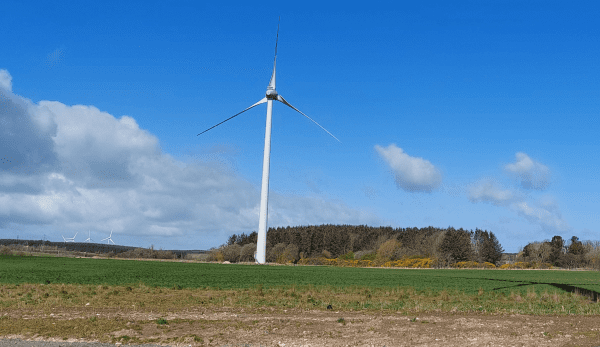
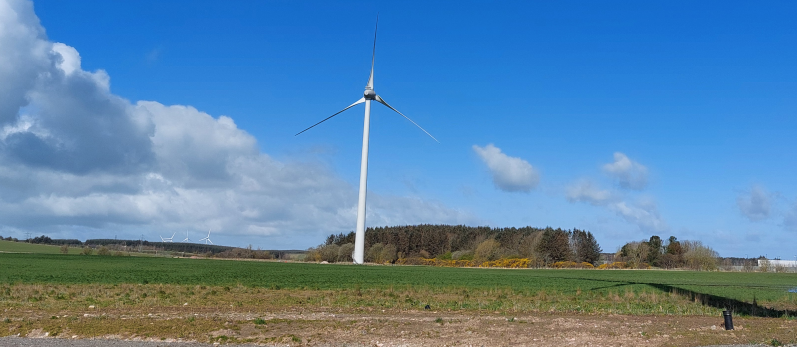
St Fergus Energy Park is located beside the village of St Fergus within Aberdeenshire Council Area. Green Cat Renewables (GCR) was engaged as planning and environmental consultants to develop the project from initial conception, through project design, consultation and full EIA. The project was refused at the Aberdeenshire Planning Committee in 2020, but GCR appealed the decision and permission was granted for two wind turbines, a solar farm and battery storage units by the DPEA in 2021.
Green Cat Renewables was then engaged as Owner’s Engineer and Designer. Construction began in 2022 with new access tracks and crane hardstandings constructed onsite. National gas pipeline infrastructure passes under the site so Green Cat had to design protection slabs and agree working methods for installing the slabs and tracks with Scottish Gas Networks, National Gas and SSE Thermal to allow civils construction to progress.
Piling (bored piles) was completed for the foundations of the two wind turbines and the bases then constructed to Enercon’s design.
A brick-built substation was constructed to Scottish and Southern Electricity (SSE) specification.
Two Enercon E-83 3MW turbines were installed onsite in Autumn 2023 and the turbines were energised and commissioned in Spring 2024.
The next phases of the Energy Parks will consist of installing the 5MWp solar photovoltaic farm, battery storage units and associated infrastructure.


Garth Wind is a community-led project that sees five E44 class- one wind turbines, with a total generation capacity of 4.5MW, connected to the Shetland electricity distribution network as part of the NINES (Northern Isles New Energy Solutions) project. The developer appointed Green Cat Renewables (GCR) as their Client’s Engineer, which entailed the roles of NEC3 Project Manager and CDM Principal Designer.
The site, which enjoys very high wind speeds, is located on North Yell, one of the northernmost parts of the Shetland Archipelago, and is covered in blanket bog peatland.
The project relies on the Feed-in Tariff scheme, for which final commissioning by early March 2017 was necessary. However, on site works could only commence in September 2016. Under significant pressure, GCR managed the construction of 2km of access road and five cranepads over peatland, and the construction and commissioning of electrical substation, comms infrastructure and the turbines themselves on time, in spite of difficult conditions and challenges.
GCR’s scope entailed managing and overseeing the discharge of planning conditions, the procurement of project funding, the procurement and management of civil engineering and electrical engineering enabling works, the management of turbine installation and commissioning, grid connection, installation of satellite communication equipment and Active Network Management set-up, and the accreditation of the project under the Feed-in Tariff scheme.


Gawnsmoss, Cairnhill and Gledsgreen are three 800kW wind turbines built on three neighbouring farms near Banff, in Moray. The three developments, which share a Distribution Network grid connection, are developed by three Community Interest Companies for the benefit of the local community and qualified for Local Energy Scotland funding.
In addition to funding given under the Scottish Government’s Community And Renewable Energy Scheme (CARES), a bank loan was also required to construct the developments. Green Cat Renewables provided Financial Procurement helping the developments obtain loans from Close Bothers while negotiating Power Purchase Agreements for the turbines, and managing an extremely accelerated Meter Operator appointment and meter installation.
Green Cat Renewables were employed by the CICs in late October 2016 to provide project management and client’s engineer services. No work on site had started at that time, and the project required three sets of:
All of which needed to be completed before the Feed-in Tariff deadline at the end of March 2017.
GCR worked closely with the landowner, civil and electrical contractors, turbine manufacturer, DNO and other parties to ensure the successful and timely build and connection of the developments.


The Gleann Casaig Hydro Scheme is located in the Loch Lomond and The Trossachs National Park.
Green Cat Renewables provided post planning management, detailed scheme design, planning conditions discharge, technical procurement services and Client’s Engineer services.
The key elements of this project are:
INTAKE STRUCTURES
The scheme has 1 main intake and 5 secondary intakes which provide water to a pressurised pipeline.
Due to the extremely low gradient of the top section of the pipeline, the main intake was required to be over 5m tall which posed major challenges due to the poor ground conditions and very limited site investigation before works started due to lack of access.
Two types of secondary intake were used on the scheme: 2 shuttered concrete and 3 prefab steel box intakes.
PENSTOCK
The pipeline from the main intake to powerhouse is 2,800m long. The upper, low pressure section is of HPPE and the lower, higher pressure section ductile iron (DI).
POWERHOUSE
The powerhouse is a steel portal frame with concrete block infill. Planning conditions required that the roof is covered with grey profiled tin and external walls are clad with vertical dressed timbers. The acoustic doors and louvres ensure that sound emissions are kept within planning requirements.
The scheme has an 11kV high voltage connection which requires a private substation (transformer and switch gear) which is contained within a prefab unit.


The Glen Ullinish Wind Farm is located to the south-east of Dunvegan on the Isle of Skye close to the operational wind farms at Ben Aketil and Edinbane. Green Cat Renewables was engaged as planning and environmental consultants to develop the project from initial conception, through project design, consultation, full EIA and eventual planning consent.
The final layout design is the result of an extensive and diligent design process which aimed to strike the optimum balance between minimising environmental impact, respecting engineering requirements and ensuring a viable scheme in terms of energy production. The key design principles behind the proposed scheme aimed to:
Extensive pre-planning consultation was undertaken with The Highland Council and key consultees including SEPA, SNH and Historic Scotland. The pre-planning advice offered throughout the process was incorporated into the project design and closely followed in the EIA process.
Planning application submitted in October 2014 and following a positive recommendation from the planning officer was consented at The Highland Council North Area Planning Committee in March 2015.
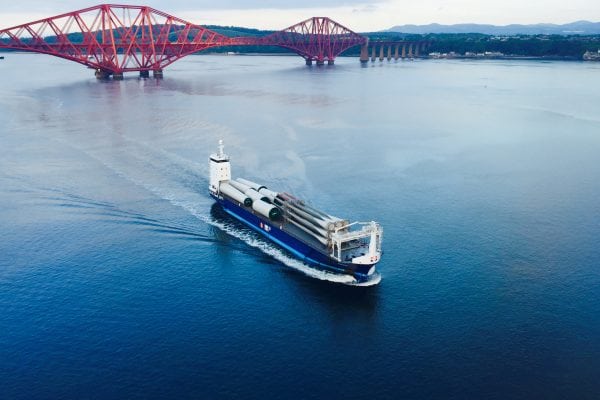
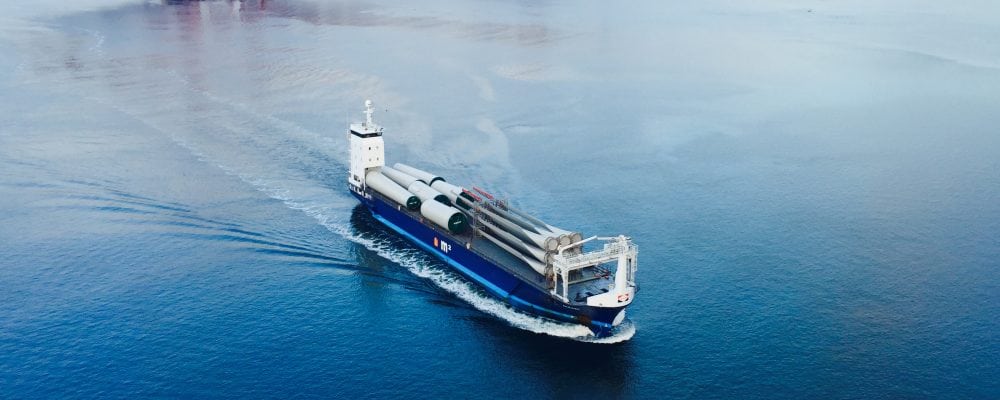
Green Cat Renewables (GCR) was appointed the lead Environmental Impact Assessment (EIA) consultant for the onshore infrastructure of the Green Volt Offshore Wind Farm, a national development. The project comprised an onshore cable route and substation which will connect the offshore wind farm to the national grid. The project starts at the landfall location to the north of Peterhead and crosses Aberdeenshire for approximately 35km to the connection point at National Grid’s New Deer substation.
he project will provide oil & gas (O&G) platforms in the outer Moray Firth with renewable electricity, harnessed from the proposed Green Volt Offshore Windfarm. It will also provide renewable energy to the Scottish mainland via a subsea export cable that will connect onshore to the National Grid.
The project aims to be operational by 2027 and creates the opportunity to mitigate approximately 500,000 tonnes of Carbon Dioxide (CO2) annually. It contributes to reducing greenhouse gas by utilising wind energy, which will create a more sustainable and renewable energy based landscape in Scotland.
GCR were appointed as the EIA lead for the onshore component of the project. The role involved:
The scale of the project meant there were a large number of constraints to take into consideration along the 35km cable route. This required a high level of organisation within GCR and a high level of cooperation between the project teams.
Key Successes
The GCR team worked with appointed engineers and stakeholder team and client as one cohesive unit which enabled the EIA and planning application to be submitted to Aberdeenshire Council under a very strict timescale (August 2023). The cooperation continued postsubmission and consent was obtained from Aberdeenshire Council in March 2024 which allowed the client to meet the CFD date. This was the result of a massive team effort from all involved.


This project was taken through the planning consent phase by the landowners directly, but ran into difficulties due to grid constraints. At this point the landowners were ready to sell the project, however, we offered an alternative which was for Green Cat Renewable Developments to come in as a Joint Venture partner.
We successfully negotiated a grid connection that worked and allowed the project to proceed. We were also able to negotiate a finance deal for the project.
Other notable challenges on this site were that the turbine had been forced into a somewhat compromised location by the need to hide it under a military radar. This meant that the turbine was located on a steep section of hillside adjacent to quarry workings. Our engineers working with Green Cat’s Geotechnical Team were able to design extensive earthworks to make space for the crane hardstanding and set down area whilst not compromising the wind resource.
The project was completed in 2016 and is now operating successfully.


The Heysham Port Wind development comprises a single EWT 500kW direct-drive wind turbine, positioned on the north quay of the harbour at Heysham. The developer appointed Green Cat Renewables (GCR) as their client’s engineer, which entailed the roles of NEC3 Project Manager and CDM Principal Designer.
The site is on land at the active port which is operated by Peel Ports and serves commercial goods transport and passenger ferries to Ireland and the Isle of Man. GCR liaised closely with Peel Ports, ensuring work was carried out without disruption to the port.
The development at Heysham is located on the historic Northern Wharf; which is man-made ground built at the end of the 19th Century. GCR undertook contamination surveys to ensure planning condition discharge. Furthermore, we undertook detailed site investigation, prepared tenders, and managed out the separate foundation and piling design-and-build contracts.
By working closely with the contractors and designers, GCR were able to ensure an appropriate design for the wind turbine foundation, at best possible price.
Heysham Port Wind Turbine was one of a large portfolio of 500kW FiT wind projects for a single developer, all successfully delivered by GCR.


The Hill of Glaschyle Wind Farm is located 2km east of Dunphail and 10km to the south of Forres. Green Cat Renewables was engaged to act as the Technical Advisor to the funder, Close Leasing Ltd, to enable construction project finance.
PRE-CONSTRUCTION SERVICES
require the production of a Report which considers the following:
PLANNING
Planning consent review, noting outstanding conditions, conditions with long-term impact, and ensuring project documents comply.
WIND YIELD ANALYSIS
Review of Wind Resource Report, wind protection zone proposals, suitability of selected turbine model, and potential impact of existing or proposed wind farm developments.
TURBINE SUPPLIER
Overview of turbine supplier and a review of the Turbine Supply Agreement, and of the Maintenance and Service Agreement.
GROUND CONDITIONS
Review of potential for impact on turbine foundations and civil enabling works.
TRANSPORTATION
Review of access issues, required permits, route selection, site access and required highway works.
GRID CONNECTION
Offer and Agreement noting characteristics of connection, timescale, scope and requirements.
CIVIL & ELECTRICAL WORKS
Review of Balance of Plant Contracts noting contractors, type of contract, scope, timescales, warranties, and designs.
GENERAL
Review of the Quality Assurance and Health and Safety of a project.
PROGRAMME
Review of Works Schedules and Interfaces between documents.
FINANCE
Technical review of costing information including contingency.
CONSTRUCTION SERVICES
require the performance and reporting of site visits to confirm the following key stages have been suitably achieved: Setting-Out, Foundation Construction, Access Construction, Turbine Erection, and Commissioning.


Green Cat Renewables (GCR) was engaged by Berwickshire Community Renewables (BCR) to provide development support during the build-out phase of the Hoprigshiels Wind Farm, acting as Client’s Engineer.
The Hoprigshiels Wind Farm project is a joint venture between two charities: Community Energy Scotland (CES) and Berwickshire Housing Association (BHA) who came together to form BCR.
BHA identified that in order to solve the shortage of social housing stock in Berwickshire, they would have to take an innovative approach. In looking at ways to address the issue, BHA embarked on developing the Hoprigshiels wind project – a project located within the local community, to serve the local community. BHA will use the project revenues to build 500 affordable homes in Berwickshire over 25 years – making it the first wind farm in the UK to use project revenues to build social housing. CES are planning to use the revenues they receive from the project to reinvest and support community projects across Scotland.
GCR’s sister companies, Prelec and Green Cat Contracting, constructed the civil and electrical enabling works for the project including: turbine foundations, roads, substation buildings and all internal electrical infrastructure between the turbines and substation.
The project was successfully commissioned in March 2017, ahead of the closure of the ROC programme. The three turbine project is expected to generate just under 25,000MWh annually, enough energy to power around 5,900 households.


Green Cat Renewables (GCR) provided all elements of consultancy and development support services for this unique project ranging from initial conception, planning, build and into operation and maintenance management.
Three wind turbines were developed on the site in 2010 by GCR and are some of the best performing wind turbines in mainland UK with an average load factor of over 40%. Solar PV technology was later added following a detailed generation study with the aim of balancing the export profile across the year, thereby utilising the existing grid connection capacity. The construction of combined wind and solar sites is advantageous to the developer providing a greater consistency of generation across the year, levelling out the natural peaks and troughs of the generation profile when these technologies are isolated. The combination of the generation profiles of wind and solar are a particularly good fit as they tend not to coincide. This means that a grid connection for the full combined capacity is not necessary in most cases.
The export limit of the House O’Hill development is 3.2MW, however, the addition of solar has increased the total installed site capacity to 4MW. This has been calculated as the optimum scale of solar installation with the resource and curtailment analysis identifying a curtailment requirement of only 3%. Green Cat undertakes similar studies to match on-site demand with generation.
GCR undertook all environmental and technical assessments required to ensure a viable project was established. The team continued on to successfully gain planning consent; managed construction of the scheme; and continue providing O&M services for the entire project.
The co-location of wind and solar technologies has proven to be a success at this development, by optimising the grid connection infrastructure. A feasibility study has also been undertaken for the addition of battery storage to provide further optimisation to balance the wind and solar resource variability, maximising revenue by enabling continuous maximum export; the overall cost benefit analysis did not support implementation at the current time.


Green Cat Renewables (GCR) provided Operational Due Diligence, Technical Advisory Services, Asset Management Services, and Operational Energy Yield Assessments for all nine sites in the portfolio. The nine sites range from a 470kW scheme to a 1,350kW scheme and total 6.5MW. Turbine types employed include Pelton, Turgo, and Francis.
Initial Technical Due Diligence was carried out to support project acquisition and included identification of technical risks relating to planning consent, lease arrangements, Controlled Activity Regulations (CAR) License, hydro resource, civil design, turbine specification, grid connection, Ofgem accreditation, O&M contracts, and operational reports. In addition, a carbon assessment and site visit were undertaken for each project.
As part of the hydro resource assessment, each site was modelled individually based on intake location, penstock, and turbine design. A combination of onsite measured flow gauging data and estimated flow data from Low Flows 2 software was used for the resulting energy yield assessment with P50 and P90 estimates generated to inform the acquisition bid.
Operational Reports from each site were reviewed to identify causes of loss of generation and highlight significant ongoing maintenance issues. Recommendations were made on the identified maintenance issues and associated trends in the turbine logs data, to potentially increase future energy production.
Operational Reports were further investigated to analyse hours of downtime attributable to grid outages and grid related downtime. This was supported by a review of grid reinforcement works on the wider network to inform future grid downtime. Site visits were undertaken to verify observations made in the civil design review and hydro resource assessment, teamed with a H&S audit to ensure compliance with relevant guidance.
Following acquisition GCR conducted annual site visits and quarterly reviews to ensure continued optimal performance.


GCR acted as Client’s Engineer for Temporis Wind as they developed this two turbine project in Aberdeenshire. The enabling works for the project involved a 2.5km grid connection, 240m of new track, 600m of upgraded track, 1000m of asphalt finish road widening on an existing private road, and undergrounding 250m of overhead BT telecoms line.
The key elements undertaken by GCR were:


Green Cat Renewables (GCR) was engaged by Netherburn West Limited to provide development support during the construction phase of the Netherburn West wind turbine project, acting as Client’s Engineer, having previously assisted the Client with the planning phase of the project.
The Netherburn West project is a joint venture between a local landowner and the Lesmahagow Development Trust (LDT). The Landowner and LDT had already previously worked together on a 3 turbine project which was commissioned in 2015. The Netherburn West project is essentially an extension to the existing project, and utilises a lot of the existing infrastructure including tracks and grid.
The Netherburn West project is the first project GCR have built out under the new FIT regime – with the project securing pre-accreditation in April 2017. Utilisation of existing shared infrastructure was essential to keep costs down and ensure the project was viable.
In our role as Client’s Engineer, Green Cat were responsible for the following:
In addition to our role as Client’s Engineer, Green Cat also provided the following services for the project:
Our sister companies, Prelec and Green Cat Contracting, constructed the civil and electrical enabling works for the project.
The project was successfully commissioned in November 2017, ahead of FIT deadline of March 2018. It is expected to generate just under 2,300MWh annually.


Nevis Range Hydro is located on the Allt Choille-rais Burn on a subsidiary ridge of Aonach Mor. It lies within the Ben Nevis and Glen Coe National Scenic Area.
Green Cat Renewables were contracted to provide the feasibility assessment, EIA assessment, planning submission and support, CAR Licence application, ongoing liaison with regulatory bodies, detailed scheme design, technical procurement services and Client’s Engineer services.
The key elements of this project are:
INTAKE STRUCTURE
The single intake is 15m by 2.5m and spans the burn, encompassing a 2.5m x 1m inclined alpine screen.
PENSTOCK
The pipeline is 1,410m in length, head 310m from intake to powerhouse. The upper, low pressure section is HPPE and the lower, higher pressure section ductile iron (DI).
POWERHOUSE
The building is situated upstream of the existing Rio Tinto Alcan hydro scheme intake. It houses two turbines with a total generation capacity of 1.1MW.
ON-SITE USAGE
The scheme supplies energy to the Nevis Range Mountain Resort via a private 11kV underground cable. All surplus energy is exported to the grid.
CONSTRUCTION
Construction of the Nevis Range Hydro Scheme was particularly challenging. Rope access was used at the steepest section. To minimise environmental impact during construction, on the upper sections, a walking excavator was used and materials and pipe were transported by helicopter.


Green Cat Renewables provided technical advisory services for the procurement of pre-construction finance for the project. With a dedicated and experienced team and established working relationships with funders and their legal advisors, Financial Close to pre-construction finance was achieved in just six weeks.
Green Cat Renewables undertook the full technical due diligence review scope. This compromised overall technical site configuration including component bankability; planning; environmental and site conditions; grid connection; energy yield; construction and operational contracts; and technical review of finances. Technical advice was also provided to support the negotiation of technical contract terms, ensuring a competitive contract and minimising overall project CAPEX to the Community.
Inspections were undertaken throughout construction, and in supporting the small scale and community nature of the project, dedicated snagging visits were also completed on behalf of the funder and Community.
Southill Solar Park was successfully commissioned in November 2016, and will benefit from the Renewable Obligations Order subsidy scheme. Following successful delivery of the technical due diligence review, Green Cat Renewables are now appointed to undertake ongoing operational monitoring and asset management for the site.


Stank Burn Hydro is a run-of-river scheme situated on the slopes of Ben Ledi, in the Breadalbane area of the Loch Lomond & Trossachs National Park.
Green Cat Renewables carried out the Client’s Engineer role which included: discharge of planning and CAR licence conditions, detailed design, Health and Safety/CDM, technical procurement, contractor management and construction supervision.
The key elements of this project were:
COMMUNITY HYDRO
The Callander Community Develop- ment Trust initiated the development of this hydro project. It was the first community hydro project in Scotland. Initial steps included an assessment of hydropower development potential within the Callander Community Council administrative area.
INTAKE STRUCTURE
The intake, incorporating a coanda type screen, is situated on the lip of a broad corrie area, close to an existing culvert.
PENSTOCK
The HPPE pipeline is 860m in length from intake to powerhouse with a maximum pressure of 16bar.
POWERHOUSE
The powerhouse is a steel portal frame with concrete block infill. The roof is a single pitched design with a grey profiled tin covering. The structure is clad with locally grown larch timber. The acoustic doors insure that sound emissions are kept to a minimum.
The turbine is a Gilkes twin jet pelton machine which has 650mm runner diameter and operates at 750rpm. It is connected to a 495kVA 3 – phase 415V generator.
ACCESS
All elements of scheme can be accessed by existing forestry tracks. No new permanent tracks were required.
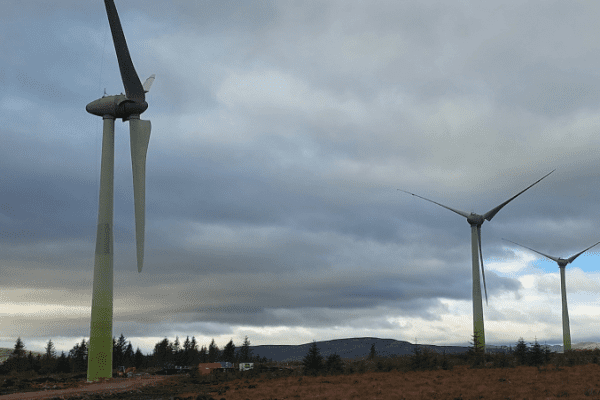
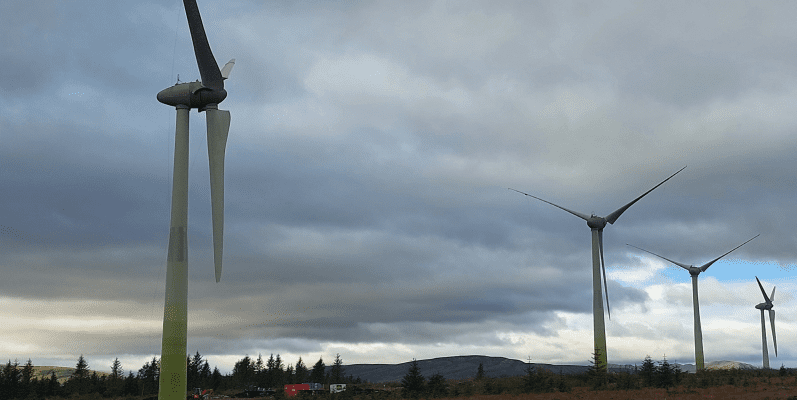
Strathallan Wind Farm is located in the hills which lie between Strathearn and Strathallan, within Perth & Kinross. Green Cat Renewables (GCR) was engaged as planning and environmental consultants to develop the project from initial conception, through project design, consultation and full EIA. The project was refused at the Perth & Kinross Planning Committee in 2016. GCR appealed the decision and permission was granted by the DPEA in 2019.
GCR was then engaged as Owner’s Engineer and Designer. Construction began in early 2023 with over 3km of new access track constructed onsite. All the stone was won from a site borrow pit, saving the requirement to import over 60,000T of stone.
Due to GCR’s extensive experience of working on challenging sites with high quantities of peat, the design was optimised to use a mixture of floating and traditional founded track depending on peat depths across the site. Utilising floating tracks helped reduced peat excavation by an estimated 20,000m3.
Foundations were designed based on site specific ground conditions using 3D modelling techniques therefore reducing concrete and reinforcement required by up to 50% compared to a standard foundation design.
A brick built substation was constructed to Scottish and Southern Electricity (SSE) specification.
For Phase 1, four used Enercon E-70 turbines were purchased from Business in Wind (BiW). These were inspected and dismantled in the Netherlands in early 2023. They were then stored by BiW and modified for the UK market before being shipped to the UK and installed onsite in Autumn 2023.
Energised in Spring 2024, the wind farm has started to export to the Grid.
The next phase of the Strathallan Project will consist of installing the remaining 5 turbines included in the Planning Permission and utilising these to power a proposed Hydrogen Plant to produce Green Hydrogen.
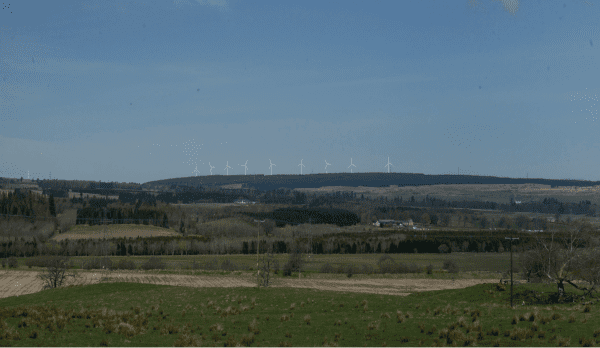
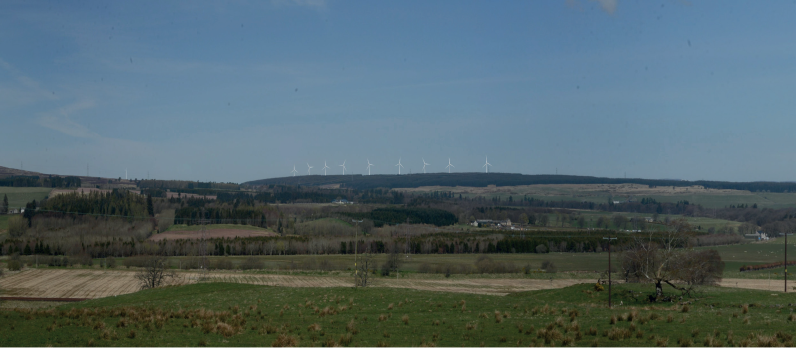
The Strathallan Wind Farm is located in the hills which lie between Strathearn and Strathallan, within Perth & Kinross. Green Cat Renewables was engaged as planning and environmental consultants to develop the project from initial conception, through project design, consultation and full EIA. The project was refused at the Perth & Kinross Planning Committee in 2016, but GCR appealed the decision and permission was granted by the DPEA in 2019.
A previous application for four wind turbines with a 100m tip height on this site was refused in 2009. In order to overcome the refusal reasons the scheme was redesigned to have a lower tip height and a higher energy production than the previous proposal, while not increasing visibility.
In between the previous application and the redesigned submission, the local authority’s landscape capacity study had been updated, and the site was considered suitable for a certain scale of development. It was vitally important for the site design to follow the guidelines set within this. The final design took account of the following:
A Community Benefit Fund was offered as part of the development. This consisted of an annual payment of £5k per installed MW, with the money to be distributed within the local area, including the communities of Braco, Muthill, Crieff and Comrie.
A planning application was submitted to Perth & Kinross Council who refused planning permission at the Planning and Development Committee in April 2017. An appeal was then issued to the Scottish Government in July 2017 which was allowed by the DPEA in January 2019. This decisin recognised the wind farms design fitting with the criteria of the landscape capacity study.
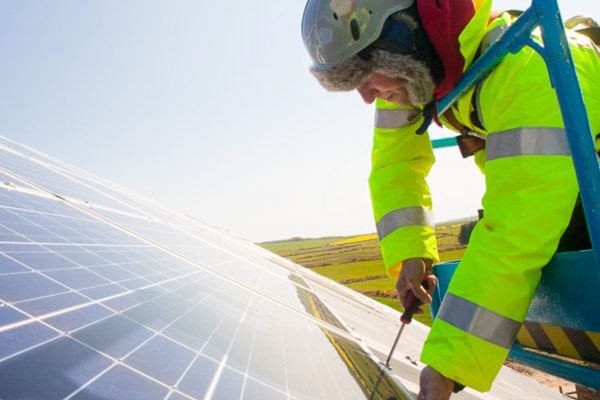
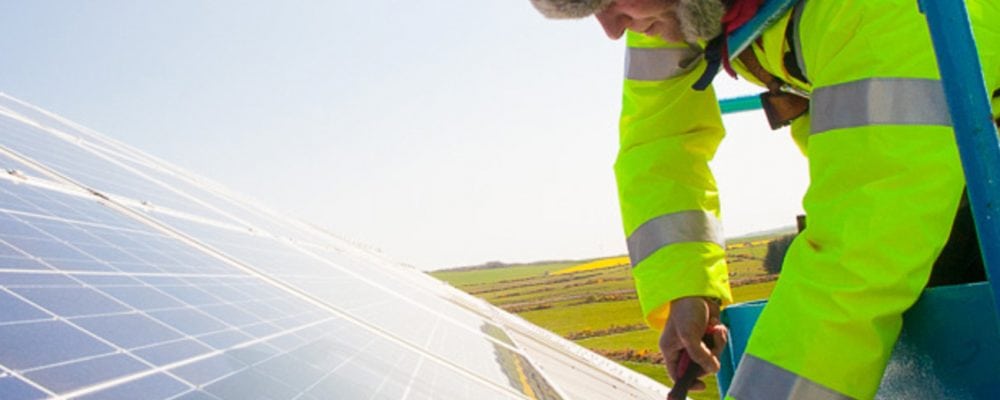
Green Cat Renewables (GCR) provided Pre-construction Technical Due Diligence for a portfolio of three rooftop solar installations totalling 2.6MWp on the roofs of large supermarkets. The rooftop arrays supply the host supermarkets energy, contributing to a reduction in import of energy from the grid.
Pre-construction Due Diligence focused on a review of the site configuration, planning requirements, electrical design, structural appraisal and roof condition, CDM and H&S, and grid connection. Additionally, assumptions made within the contractors Energy Yield Assessment were reviewed and an analysis of the user’s energy consumption undertaken to quantify the contribution the rooftop array would make to the building’s energy import.
The consumption analysis indicated that over 97% of energy generated by the solar arrays would be consumed by the supermarkets, reducing the import requirements by 18% across the sites.
Cable runs, electrical configuration, location of inverters, shut-down procedures, access, roof conditions, and roof penetrations were all considered when assessing the suitability of the design. As the sites are located in a built-up area with roofs at a low inclination angle, soiling on the panels was a consideration and recommendations were made for cleaning of modules and loss assumptions within the Energy Yield Assessments.
Grid constraints at each site required the incorporation of G100 limitation devices with GCR conducting an assessment of potential curtailed export.
The post-construction review looked at the project completion documentation for suitability for the ongoing operation of the sites. Provision of sign-off documentation and DNO approval was essential to allow continued export of energy to the grid, and relevant Health & Safety documentation was reviewed to ensure compliance with relevant Health and Safety guidance.
A review was then conducted of the Contractors Performance Ratio (PR) calculation to verify methodology and adherence to the EPC Contract.


Green Cat Renewables provided development support ranging from initial technical assessments to the delivery of planning consent including community engagement and landscaping designs.
As the site is located in one of the best areas in Scotland for levels of sunlight, a solar farm was considered an ideal opportunity to maximise the land use of the former airfield.
The design of the development has allowed for the land to have a dual purpose:
The solar farm will allow for small/ medium sized livestock, such as sheep, to graze the land in-between the rows, and underneath, the panels.
A public exhibition was held in the local community hall to provide information to local residents.
The site has provided poor quality wildlife habitat due to its former use as an RAF Airfield. As a result of the solar park, it is proposed to improve the quality of wildlife habitat and biodiversity by:
The application was well supported by the local Councillors and was approved by the Development Standards Committee of Angus Council.


Tormywheel Wind Farm comprises a 30+MW, 15 turbine development south of Whitburn within West Lothian. Green Cat Renewables (GCR) assisted the developer Muirhall Energy to finalise the design layout, compile tender scope and award a Design and Build contract in March 2016 for completion by March 2017.
GCR acted as the Client’s Engineer, liaising with stakeholders preparing tenders, and managing the three separate contracts for Balance of Plant, Turbine Supply and Grid Connection. The role of CDM Principal Designer was also included to
ensure compliance with CDM 2015 Regulations.
The site is located on elevated peaty moorland adjacent to an operational landfill site. GCR Geotechnical carried out the ground investigation study which included mining investigation and contaminated land reviews, alongside the standard site investigation to inform foundation design.
To achieve the March 2017 Ofgem ROC deadline it was necessary for GCR to actively co-ordinate actions of all the parties involved.
Muirhall Energy has a portfolio of several wind projects three of which have been successfully delivered by GCR.


Green Cat Renewables (GCR) acted as the Client’s Engineer, including providing assistance with the commercial negotiations between the factory and client to allow export from the turbine to supply the factory.
Due to the transmission constraints in the local area, the site would not be able to export the full 1.5MW onto the WPD network until summer 2017. The network operator, WPD could only offer a 50kW connection prior to this date. To ensure the higher FiT tariff was secured a deal was struck with the neighbouring factory, Sibelco, to supply them with power from the turbine. This meant integrating the turbine and factories connection together.
GCR assisted with the design of the electrical configuration to ensure that no more than 50kw was exported to the grid. A controller was installed at the point of connection to curtail the turbine when the power consumed by the factory, plus the grid export, was less than what the turbine could produce at that moment in time.
This also created a complex metering configuration where the requirement was to incorporate half hourly meters at each respective entry point. GCR designed the metering set up as well as successfully arranging an appropriate supply company to apportion how much of the turbines generation is used by the factory.
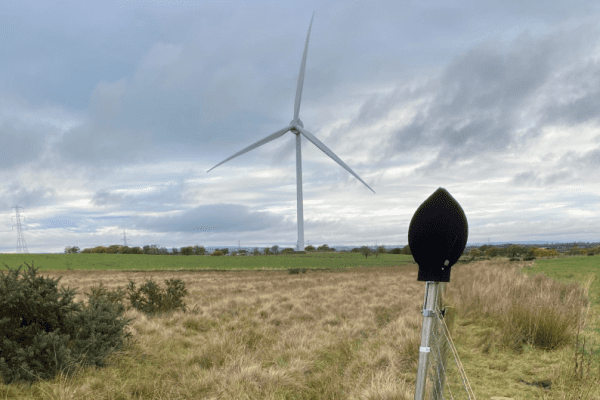
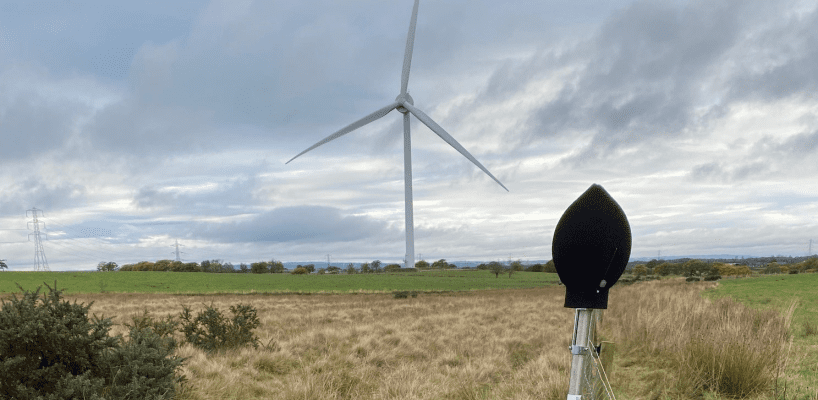
Watsonhead Wind Farm is located in North Lanarkshire and were the first Enercon E138’s to be built in the UK. Green Cat Renewables (GCR) was engaged as planning and environmental consultants developing the project from initial concept feasibility, through EIA to planning consent.
As the appointed noise consultants for the project, GCR provided noise feasibility input, scoping, and noise impact assessment for inclusion within the EIA. Following an amendment to the project to increase the size and capacity of the turbines, an updated NIA was submitted demonstrating the wind farm would not cause significant impacts in terms of noise.
The NIA was produced in line with ETSU-R-97 and the Institute of Acoustics Good Practice Guide. A cumulative assessment was also conducted which included over 80 third-party turbines.
The development was first consented in December 2021, with the proposed amendments being accepted in October 2020.
Since the project became operational in 2022, GCR has also provided post completion noise compliance testing. This involved deriving the operational turbine noise and assessment with the consented noise limits at the nearest sensitive receptors.
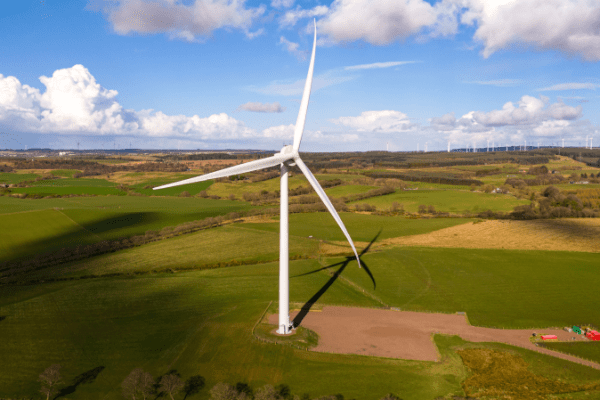
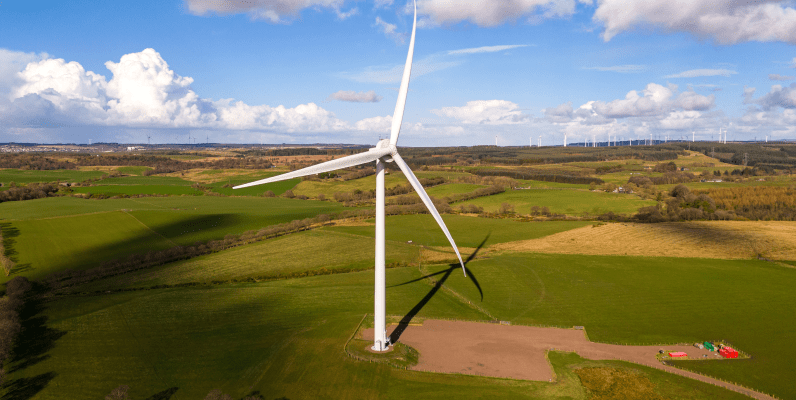
Green Cat Renewables (GCR) were contracted as Clients Engineer and Electrical Designer for the Watson Head Wind Farm Project following the successful delivery of the initial scoping phase as well as the initial and revised planning applications to increase the consented maximum blade tip height to 150m from 135m.
Watson Head Wind Farm is located east of Wishaw. The wind farm development consists of the supply, delivery, erection, and commissioning of two Enercon E138 wind turbines and associated access tracks, crane hard standings, foundations, drainage systems, underground cables, and substation building.
As Clients Engineer, GCR were responsible for carrying out the discharge of planning conditions, procurement of all enabling contracts (BoP, TSA and ICP) and management of the contractors through the pre-construction and construction phase. Other responsibilities included Initial Civils Design, Grid Connection Management, Construction Supervision and Route Access Suitability.
The project was the first in Scotland and the UK to comprise of Enercon E138 turbines.
GCR, as the Electrical Designer for the project, were also responsible for the detailed electrical design of the site and the connection.
System Studies
Electrical Design


Green Cat Renewables (GCR) first started work on this project in 2007. Problems during planning meant that it was only consented on appeal in 2012. Even after consent was granted the grid connection was prohibitively expensive, however another wind project was consented nearby and we were able to negotiate a joint grid connection and hence bring the price down to an affordable level.
Whilst the principal of the shared connection should have led to savings of ~£2M on the original quote, in practice the shared connection brought significant additional problems and costs. It was deemed necessary to seek a planning consent for the ICP works, this was relatively straightforward and was granted in 2015. However, an objector to the nearby project raised a Judicial Review action against the consent as a way of trying to prevent both projects proceeding. This action and the subsequent appeal delayed the projects for 18 months. The shared grid also caused issues with the finance as the lenders for both projects struggled to get comfortable with a situation where neither project was in overall control.
Working with the neighbouring project we were able to devise a mechanism whereby both projects deposited their share of the ICP moneys in an ESCROW account that was managed independently and with a control protocol that meant neither developer could detrimentally affect the other’s project. The lenders were comfortable with this arrangement.
The shared grid infrastructure had a side benefit that as neither project was a sole asset user, the DUoS charges were significantly reduced.


Green Cat Renewables provide a range of engineering & project management services required to economically & successfully deliver renewable energy projects.
With our team of experienced engineers and technical staff Green Cat Renewables can provide the full range of support services in the development, construction and delivery phase of renewable energy projects.
The scope of work required is always tailored to each project and client. This is crucial in the current renewables climate of reduced subsidies, and ensures an economical delivery of the project. Our Engineering Team are fully supported by Green Cat Contracting, Green Cat Geotechnical, Prelec electrical contractors and our Technical and Environmental department who provide invaluable input and advice through all phases of the project development.
In response to the current constraints of the electrical networks Green Cat Renewables are working with respective DNOs to provide innovative and flexible grid solutions to allow schemes to connect prior to the completion of network reinforcement.
COLLABORATIVE AND PRO ACTIVE APPROACH
Our team of engineers have built up extensive experience working with planning authorities, public bodies, landowners, communities and private developers and investors. We have good working relationships with: statutory consultees including SEPA, SNH, WOSAS; highly specialist private consultants and contractors; wind turbine suppliers Enercon, Nordex, EWT, Senvion, Gamesa and Vensys; and hydro turbine suppliers such as Gilkes, Hydrohrom and Cink.
Our experience and understanding of design and management of contracts; statutory consultee expectations; and environmental conditions, coupled with our team of over 40 technical staff enables Green Cat to quickly find effective solutions to manage the delivery and build-out of renewable energy projects.


An increasing number of turbines are being erected closer to urban centres on brownfield land and on sites with a long industrial history.
Even in apparent rural locations, historic industry can have occurred or the site may have been used as a convenient dump for industrial waste. Contamination can be mobile, so even if the site itself was never industrial, contamination may have occurred by migration.
THE OWNER OR OCCUPIER OF A SITE MAY BE HELD LIABLE
Regulators in the UK are empowered to clean up contaminated land and pass the cost onto those responsible.
Turbines would not be considered a particularly contaminative use and so land contamination can easily be over-looked. Under the current philosophy with respect to contaminated land in the UK, the principle is “the polluter pays”. On that basis, the developer may consider that he will not be held liable for any contamination. However, this is a naïve view.
Many developers do not realise that under part 2a of the Contaminated Land Act (CLA), the “owner or occupier for the time-being” can be held responsible for contamination and for the clean-up costs. Accordingly, whether the developer owns the land on which the turbine sits or rents it, he could be held liable.
A PRUDENT DEVELOPER CONSIDERS THE RISKS
In practice, the regulators know that it is easier to use planning conditions to ensure compliance than use the CLA, so they will generally impose conditions on the consent to accomplish their requirements. However, even if they do not, the client holds duties of care and must comply with other legislation in terms of the development which may have significant cost implications. The prudent developer will ask questions such as:
POTENTIAL ISSUES IDENTIFIED AND ASSESSED REALISTICALLY
GCR has considerable experience in the assessment of contaminated land issues:
With regard to development, it is imperative that potential issues are identified and assessed at an early stage in order that the implications are fully understood, costs minimised and full advantage taken of any opportunities to make significant savings.


Effective management and monitoring of operational wind and solar energy projects, providing reassurance that your assets are maximising their potential.
It is inevitable that issues will arise with operational projects. Green Cat’s dedicated O&M team ensure issues are resolved quickly and efficiently.
This service is tailored to client needs, offering a simple and effective means for the customer to manage their project, with minimal input on their part. It provides peace of mind that the development is operating to its full potential and they are getting maximum return on their investment.
The highly successful relationship we have built with manufacturers and suppliers means that we save our customers’ time and money in resolving problems.
Active monitoring of project data means problems are spotted at an early stage, and steps put in place to rectify these as soon as possible.
The service provides ongoing performance monitoring of operational sites including monthly performance reporting to investor requirements and facilitation to achieve Ofgem accreditation. Bookkeeping can be added if required.
The company currently manages twenty-seven projects including:
A typical scope of services would include:
A variety of platforms are used to monitor the sites, ranging from in-house tools to manufacturers’ own software and other third party systems.


Green Cat Renewables has extensive experience in all aspects of geotechnical assessment.
The design and execution of a well-designed site investigation is essential for the successful development of any site. Renewables projects are no exception to this rule.
Our experience encompasses scoping of ground investigations and drilling boreholes, through in situ and laboratory testing to interpretation, advice and liaison with regulators and other professionals. The company has undertaken site investigations on well over two hundred sites.
Primarily used to support the design and construction of wind and hydro projects, the Geotechnical Team can also provide a stand-alone service to clients for a wide range of projects, from a single house to large industrial developments, and including all renewable energy schemes of any size.
To satisfy the demanding requirements of a wind turbine, adequate site investigation is essential to evaluate the bearing capacity, amount and rate of settlement, stress, deformation, overall stability, durability and dynamic behaviour of the foundation. The best site investigations are designed to provide sufficient technical information in the most economical manner. GCR work closely with turbine manufacturers and use our knowledge of suitable techniques in the anticipated ground conditions to ensure best value.
A similar approach is adopted with work for hydro schemes. A topographic survey combined with trial excavations and detailed walkovers allow selection of the most appropriate locations for the weir, pipes and turbine. Advanced warning of adverse features, such as shallow rock or unstable ground, allows realistic budgets to be set and reduces the risk of high additional costs associated with unforeseen ground conditions.
Hydrological and hydrogeological conditions are assessed as part of the geotechnical investigation both from existing data and in-situ testing.
GCR offers:


Green Cat Renewables is a privately owned renewable energy consultancy based in three offices across Scotland, UK.
With a team of 50 staff across the UK, the company’s multi-disciplinary resource base spans all stages of project delivery from feasibility and concept development through to planning, engineering, project management and operational asset manage-ment. The company’s experience profile includes 600MW+ of wind, 200MW+ of solar and 25MW+ of hydro projects.
The team is supported by specialist services such as energy yield modellers, grid modellers and geotechnical engineers. GCR provides services to small scale generators such as local farmers seeking to diversify their business, through to large scale private investors who seek to develop large sites and/or portfolio investments in renewable energy. Specialist technical advisory services are also a key part of Green Cat Renewables’ capability, through due diligence and expert advice to investment banks, community groups and private investors alike. The support is tailored to the needs of the individual client throughout the entire project.
To find out more about what we can offer, please contact our offices.
Head Office,
UK Bethany Hall
29a High Street Biggar,
South Lanarkshire
ML12 6DA,
UK +44 (0) 1899 309 100 info@greencatrenewables.co.uk
Edinburgh
Stobo House,
Roslin
EH25 9RE,
UK +44 (0) 131 541 0060
Livingston
Ritchie House
Starlaw Business Park
Livingston
West Lothian
EH54 8SF,
UK +44 (0)1506 416 5533
Also
Green Cat Canada
Global Business Centre
136 8th Ave SE
Calgary
T2G 0K6 Alberta, Canada
info@greencatcanada.ca


Green Cat Renewables is a company specialising in providing the full range of technical expertise in-house to successfully deliver hydro-electric projects from feasibility to construction.
With a team of over 50 staff including civil, geotechnical and electrical engineers, as well as a dedicated planning and environmental team we have successfully helped deliver over 30 hydropower projects with a total output of over 25MW. Our clients to date have included landowners, developers and community groups.
SUCCESSFUL DELIVERY OF PRIVATELY OWNED AND COMMUNITY PROJECTS
We currently have a range of hydro projects from 50kW to 1.1MW at various stages of consent, design, construction and completion. Our hydro projects encompass a range of small hydro scheme types including:
BROAD IN-HOUSE CAPABILITIES AND EXPERIENCE
Utilising our comprehensive in house capabilities and experience, we are able to offer the full range of expertise necessary to take a hydro scheme from inception, through feasibility, obtaining necessary consents, detailed design, tender of civil, mechanical and electrical works; and the procurement of all components, to construction and generation. In doing this we always maintain good communication and working relationships with clients, councils, contractors and other official bodies such as SEPA, SNH, WoSAS, DNO bodies, OFGEM etc, to ensure our projects progress efficiently ‒ on time and on budget.
Due diligence services are provided to lenders and developers as technical adviser to provide independent analysis of pre-construction and operational schemes. A wide range of services are available including energy yield assessments, review of all permissions, civil & turbine supply contracts, O&M contracts and grid connection. In addition site visits can be conducted to provide reporting and drawdown approval on behalf of the lender.


Green Cat Renewables provide a full range of Landscape services tailored to suit the scale and needs of your project, from planning through to construction.
The Planning and Environmental Department within Green Cat Renewables have an experienced team of Landscape Consultants & Graphic Technicians, the team have supported the delivery and assessment of almost 200 renewable energy projects, ranging from small scale wind turbines to large commercial wind farms, solar parks, hydro-electric schemes, and major agricultural, commercial and utility buildings.
LANDSCAPE & VISUAL IMPACT ASSESSMENT
Landscape & Visual Impacts are amongst the most critically assessed area of any renewable energy development, especially wind projects.
Our landscape consultants provide pre-application advice to inform project feasibility and design development and LVIA to support Planning Applications, and Landscape Clerk of Work services throughout construction delivery.
As well as supporting the planning team, our team also provides stand alone LVIA, Residential Assessments, Visualisations, Planting Plans and Capacity Studies. All work is conducted according to current industry standards as set by SNH and relevant Local Authorities, utilising the latest software and technology, such as GIS Mapping, ReSoft Windfarm, Augmented Reality Real-Time Visualisation software and Adobe Creative Suites. Our teams maintain and are trained to use photography equipment in observance of both SNH and Highland Council Standards, the most stringent in the UK.


Green Cat Renewables (GCR) has extensive experience in the assessment of mining and mineral stability.
An increasing number of turbines are now being erected closer to urban centres. Many of the industrial towns in the north of the UK are located in areas with a long history of mining, dating back hundreds of years, sometimes to medieval or even Roman times. Since it was not until the late 19th Century that it became compulsory to survey mines on abandonment and lodge the plan with any government depository, many past workings are not recorded. For this reason a ‘Coal Authority appraisal’ is not sufficient even if it states that there are no recorded workings.
Whether the workings are recorded or unrecorded, it is essential to consider the stability of any workings under a turbine not just from the static point of view, familiar to those dealing with housing, industrial units, roads, etc., but also from the dynamic point of view, which requires a more in-depth knowledge and experience than is otherwise the case.
Some risks with respect to the mineral stability of a site are potential ‘showstoppers’. For example, if a mine shaft is located under or within influencing distance of the proposed turbine, then construction of the turbine at that position will normally not be practicable. Moving the turbine position at an early stage of planning is not usually a significant issue.
However, if this proves necessary late in the process, then problems leading to significant issues, costs and delays can occur if the planning application has to be amended to allow this.
Shallow workings may need to be grouted or the foundation loadings taken below the worked horizon. Either option will incur significant cost and may impact the financial viability of a scheme. It is therefore important that developers have a reasonable understanding of the risks before they approach potential funders.
GCR has significant experience in the assessment of mining issues:
GCR can also design and supervise remedial works to cope with mineral stability issues to allow development to proceed. As always with regard to development, it is imperative that potential issues are identified and assessed realistically at an early stage in planning in order that the implications are fully understood, costs minimised and full advantage taken of any opportunities to make significant savings.


Green Cat Renewables provide a full range of noise assessment services tailored to suit the scale and needs of your project.
The UK noise team at Green Cat have assessed the potential noise impacts of more than 300 renewable energy projects located throughout the UK with expertise gained from over 15 years of experience. The team’s workflow of ~50 projects per annum includes single MW projects up to >50MW developments.
The team conducts predictive noise modelling studies and establishes baseline constraints at an early stage of project development, including the production of noise contour maps, to feed into feasibility studies. These studies often include cumulative noise assessments to determine the available capacity of sites that may be influenced by neighbouring developments. Engagement with consultees is critical to the success of any proposed development and the noise team will lead in liaising with EHOs and planners to agree assessment criteria and establish noise-monitoring requirements while developing a positive and responsive working relationship.
Over the last five years and with oversight from the UK team, our colleagues in the Calgary noise team have produced noise impact studies for >1GW of renewable energy projects spanning Solar PV, Wind Energy and Energy Storage in several Canadian provinces
Noise Impact Assessments
GCR have become recognised experts in the area of wind turbine noise with skills and experience covering all aspects of the project life cycle: operational and construction noise assessments at the planning stage, discharge of planning conditions post approval, testing operational projects; for compliance with approved noise limits, tonal and sound power measurements following IEC 61400:11, the detection and rating of amplitude modulation, and in noise complaint investigations.
Beyond wind energy, the team regularly assess the potential noise impacts of battery energy storage (BESS), hydro, hydrogen, solar and industrial plant noise sources. This involves input into project design, plant manufacturer selection and mitigation design to maximise the project’s value while complying with noise limits.
Noise Complaints and Mitigation Solutions
The team has experience of applying and testing mitigation designed to reduce specific operational issues at the lowest project cost. The team have specified mitigation using acoustic barriers, louvered enclosures and brick plant buildings to limit noise breakout. The team also have experience of managing projects through noise abatement legislation by working to find effective solutions to the satisfaction of the local planning authority and have also acted as expert witness to legal proceedings when required.


Green Cat Renewables Technical Services team conducts Operational Due Diligence reviews on the technical merits of wind and solar assets to help inform investors and lenders.
Our team of analysts and engineers provide impartial technical reviews. These appraisals encompass asset contracts, warranty compliance, and performance and site condition assessments, and can be undertaken in a holistic approach.
Projects are situated across the UK, with the southernmost projects in Cornwall, England, and northernmost in Aberdeenshire, Scotland.
Site visits are conducted at each project to inspect the ‘as-built’ design, infrastructure condition and to verify contextual surroundings that may affect long term performance.
Historical energy data from turbines is processed and prepared for correlation with off-site long term reference climatic data, including enquiry into downtime periods, performance issues and environmentally impacted generation periods. Long term P50 yields are derived based on measured site data and historical climate, accounting for technical losses.
Uncertainty analyses are undertaken in order to estimate the variability of long term prediction due to measurement and modelling accuracy, as well as natural variability, and forms the basis of P90 energy production estimates.
A technical review of construction and installation contracts and operation and maintenance provisions provide a complete technical review of site infrastructure.
Further to this, a review of the following is conducted for each project:
This proportionate approach ensures key data is appraised while minimising transaction due diligence costs.
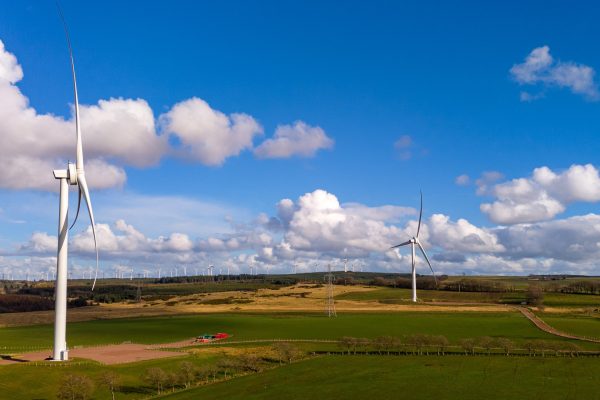
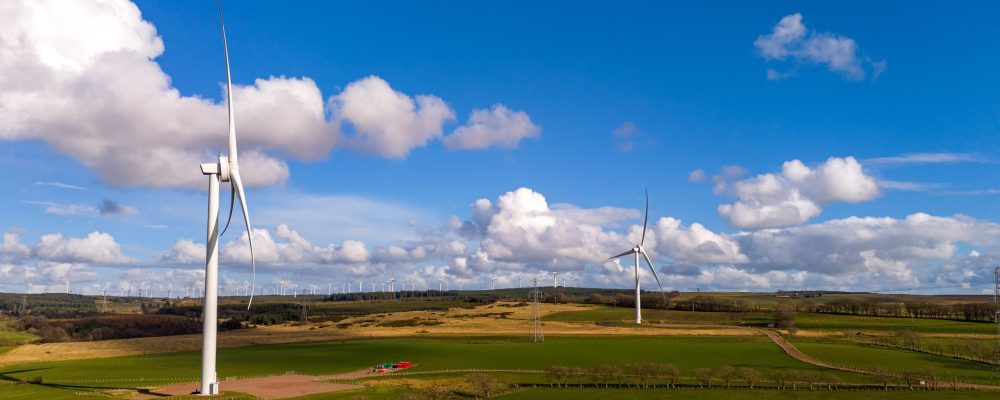
Green Cat Renewables has a vastly experienced design team on hand to support the design and development of your renewables project.
The Green Cat Renewables team includes photographers, graphic technicians and designers, with a wealth of experience producing visualisations for renewable energy developments including onshore wind, solar, hydrogen, BESS and infrastructure. The team have supported Landscape and Visual Impact Assessments (LVIAs) across the UK and Canada over the last 15 years.
LVIA Visualisations
Landscape and visual impacts are amongst the most discussed elements and often the main cause of objections related to renewable energy development. To better understand and assess these potential impacts requires high quality supporting visualisations.
The GCR team have significant experience in all aspects of LVIA production, with our team of experienced photographers, designers and technicians, the team provide visualisation support for all aspects of wind, solar, hydro, BESS, hydrogen and infrastructure projects.
Wind Farm visualisations are produced using ReSoft Wind Farm and WindPro software, in accordance with all relevant standards and guidance, most notably NatureScot and The Highland Council. The team also utilise a full suite of professional software for pre and post processing including In-Design, Adobe Suite and GIS.
Public Consultation Materials
The design team also support clients in the production of exhibition materials to present proposals to the public. This includes the creation of templates for information banners, graphics and visualisations, as well as information sheets, advertising posters, letters and any other marketing material as required.
Augmented Reality Visualisations
GCR provide an augmented reality service through the TrueView Visuals Platform. This helps to create instant visualisations that can be used on site when carrying out site selection and feasibility work, as well as initial design reviews. GCR have also utilised this tool in stakeholder meetings and public exhibitions to provide context and help stakeholders and member of the public gain an additional understanding of potential visual impacts of the development.
Drone Photography and Video
In addition to carrying out panoramic photography to produce photomontages, Green Cat Renewables also carries out drone photography and videoing, which is utilised to gain a wider understanding of landscape context, setting of historical features and general feasibility of sites, reducing the requirement for multiple site visits. Drone photography can also be used to create photomontages, which is particularly useful for development such as solar or BESS, which have a distinctly different visual impact from wind developments.


Green Cat Renewables specialises in providing the full range of technical expertise to successfully deliver renewable energy projects.
From small to large scale wind, solar PV and hydro, our team is dedicated to offering the full range of bespoke support services to economically deliver your project. Be it feasibility, planning consent, construction or operations, our Engineering, Geotechnical and Technical Services specialists provide invaluable input and advice through all phases of project development.
HANDS ON AND EXPERIENCED
Our multidisciplinary team adopt a hands-on and positive approach to design, manage and deliver a diverse variety of projects through to planning consent, from single turbine farm diversification projects to multi-MW wind farm applications. Since 2005, the team have delivered over 100 planning consents totalling 273MW (218MW Wind and 55MW Ground Mounted Solar).
COLLABORATIVE AND PRO-ACTIVE APPROACH
Our project managers have built up considerable experience working with planning authorities across Scotland and England. This in-depth knowledge of local planning policy and the established relationships with planning departments and officers has meant that almost 90% of our consented developments were able to be determined at a local level, the benefit of this to the project and client is that timescales and planning risk are both significantly reduced.
In addition the team have built up a wealth of experience dealing with statutory consultees including SNH, SEPA and Historic Scotland. Our broad understanding of planning requirements and long established relationships enable the team to quickly find effective solutions to manage planning risk. Green Cat Renewables specialises in providing the full range of technical expertise to successfully deliver renewable energy projects.


Green Cat Renewables has a wide portfolio of experience in the planning, design development, engineering, delivery, and finance of ground-mounted and rooftop installations.
Green Cat Renewables (GCR) has a demonstrated track record in securing Planning Consent, Engineering Design, and Technical Analysis of small and large scale solar PV sites. Our experience profile includes small and large scale roof-mounted solar as well as ground-mounted grid-tied systems up to 100MWp.
Our capabilities include planning applications and conditions discharge/ management; energy yield analysis including whole of life forecasting; EPC and O&M contract procurement and technical negotiations; grid connection and scope interface management; construction management and supervision; PAC, IAC and FAC acceptance review; operational performance monitoring; fault diagnosis; and warranty compliance.
Working alongside developers, investors, and finance providers alike, GCR has a thorough understanding of the key technical barriers to the successful delivery and operation of a solar PV site.
Informed by over a decade of energy resource assessment and analysis experience, GCR has developed robust and bankable methods in-house for the analysis of long term performance forecasts at both pre-construction and operational stages. Our methodology also integrates industry-standard tools including PVsyst, and our experience gives us the flexibility to respond to site specific design requirements.
Our grid analysis capabilities enable assessment of the impact on generation of network curtailment and shared grid connections.
Technical knowledge of and experience in the negotiationof technical EPC and O&M contractprovisions, including acceptance andtechnical performance guarantees.
GCR’s experience of planning and designing sites ensures that we are well placed to maximise secondary benefits for community interest groups, farmers and developers alike.

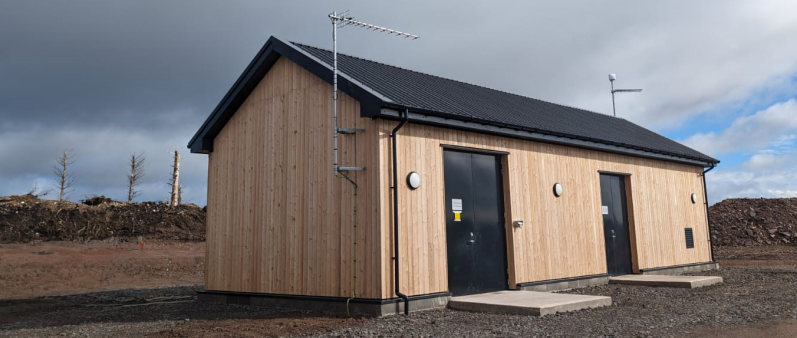
Green Cat Renewables are experienced in the design and construction of HV Substation Buildings compliant with the specifications of Distributor Network Operators.
GCR have successfully completed several substations up to 33kV specification with SSE and SPEN, utilising various materials and building techniques.
GCR has a dedicated team of structural/ civil design engineers and CAD technicians who are proficient in
structural analysis and design methodologies, ensuring the structural integrity and resilience of wind farm substation buildings.
GCR also has an electrical engineering team to aid with substation design, with extensive knowledge of electrical systems and components specific to wind farm substation buildings, including transformers, switchgear, control systems, and grounding systems. Skilled in designing electrical layouts, cable routing and equipment placement to maximize operational efficiency and reliability.
All the substation designs are 3D modelled in Revit. Setting out plans can also be supplied in AutoCAD formats.
GCR has in-house geotechnical engineers who can conduct geotechnical investigations and soil analysis to inform foundation design and mitigate risks associated with ground conditions.
Additionally, GCR has an in-house environmental and planning department with extensive knowledge in environmental considerations and compliance with permitting requirements, to minimize ecological impact and ensure regulatory compliance.
With a comprehensive skill set encompassing structural, electrical, and civil design disciplines, coupled with a proven track record of successful project delivery, GCR is well-equipped to provide tailored solutions for wind farm substation building design. Our commitment to innovation, quality and client satisfaction ensures that each project receives the attention to detail and expertise necessary to achieve exceptional results.
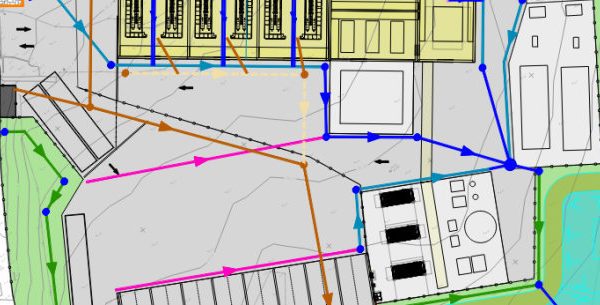
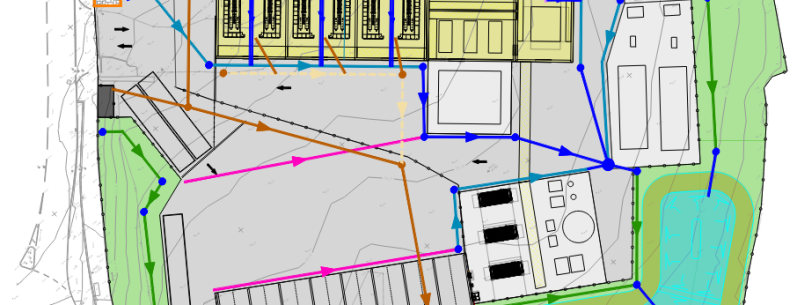
Green Cat Renewables are experienced in the designing of Sustainable Drainage Systems (SuDS) techniques to facilitate sustainable drainage solutions.
Green Cat Renewables (GCR) design SuDS solutions on various sites ranging from hydrogen production facilities to battery storage sites and wind farms. GCR also has expertise in Drainage Impact Assessments and Flood Risk Assessments.
GCR utilises the simple index approach as outlined by SEPA to determine appropriate levels of treatment to the proposed site. InfoDrainage software is used to design and model SuDS networks and to produce calculation outputs.
SuDS techniques are often costly, so GCR aims to provide passive SuDS that are also financially practical. Such SuDS techniques can be viable if consideration is given to them at the earliest opportunity in the design process. SuDS offers passive treatment of surface water run-off and attenuation; they also add green space to a project.
Often a renewable projects will be constructed adjacent to a river or stream and hence construction activities must not pollute the existing ecosystems. GCR are also experienced in dealing with construction run-off.
The goal of all drainage systems is to mimic the existing Greenfield state as closely as possible utilising costeffective techniques.
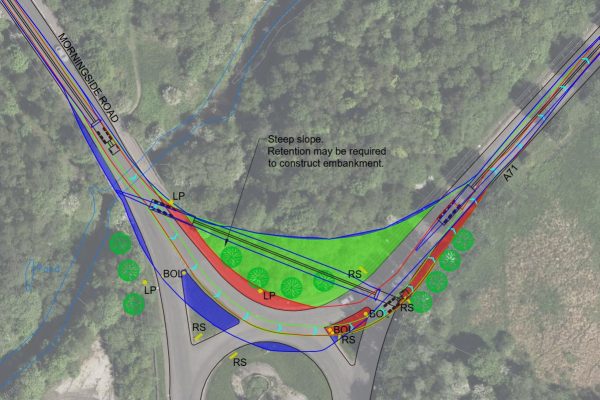
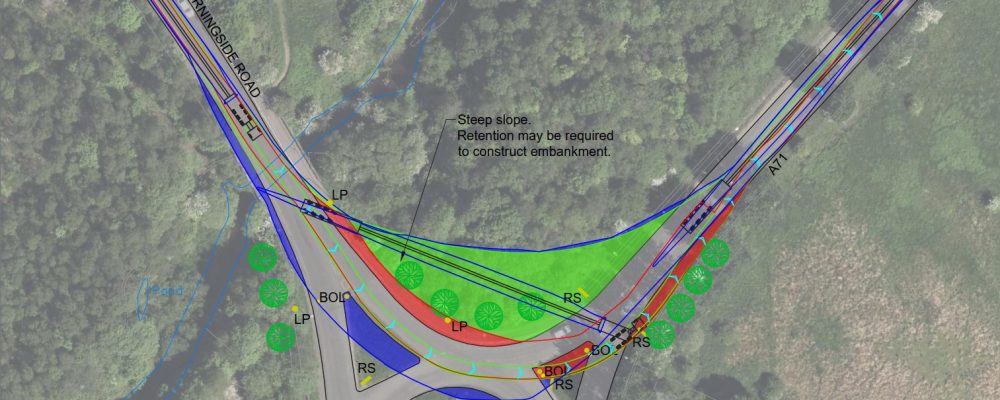
Green Cat Renewables boasts extensive expertise in abnormal load assessments, a critical aspect of wind farm development. Ensuring the efficient transportation of abnormal loads, particularly the increasingly sizable wind turbine components like blades, is paramount to project success.
Green Cat Renewables (GCR) track record includes pivotal involvement in facilitating one of the first E138 blade deliveries in Scotland.
GCR have conducted comprehensive desktop studies for upcoming blade iterations, some stretching up to 80 meters in length, for deployment throughout Scotland.
GCR’s meticulous approach extends to providing swept path analysis drawings for all turbine components, including blades, tower sections, generators, and crane equipment. GCR have built up an extensive library of wind turbine delivery vehicles to use in Autodesk Vehicle Tracking software.
In response to evolving challenges, such as navigating complex routes, we have embraced innovative solutions like blade lifter vehicles. These specialised vehicles enable manoeuvrability through previously inaccessible bends. GCR must consider a variety of obstacles that are involved with blade lifter vehicles such as blade transfer locations & storage compounds, wind speed considerations during deliveries, overhead and tree lines.


The Technical and Environmental Services team brings a wealth of experience in planning, review, assessment and ongoing management of hydro, solar and wind energy projects.
Our technical advisors and environ- mental planning specialists have practical experience in the planning, analysis and engineering delivery of renewable energy projects, enabling Green Cat Renewables to provide a holistic approach to the environmental and technical analyses required by developers, funders, landowners and other project sponsors.
The experience of our team is supported by the broad geographical coverage of wind and solar evaluations undertaken to date in the UK from Cornwall to the Orkney and Shetland isles. We also offer snagging and construction stage site inspection services, with working-at-heights qualified team members.
We are therefore able to provide project development support at all scales and stages of development.
PLANNING & ENVIRONMENTAL are our dedicated team of Environmental Consultants, Project Managers, Engineers and Technical Specialists, providing the full range of support services, tailored primarily to economically deliver small to large scale wind and solar PV projects from initial feasibility through to planning consent.
DUE DILIGENCE technical reviews for a range of leading banks and private equity investors. Proactive approach to working together with investors, advisors, developers and stakeholders to mitigate technical risks and enable financial close.
ENERGY YIELD ASSESSMENT for wind, solar and hydro schemes across the UK, informing project benefits to assist in the financing process in a cost effective and flexible manner.
NOISE ASSESSMENT at both pre- construction and operational project phases, ensuring planning conditions can be met and post completion issues can be addressed.
MANAGEMENT SERVICES to provide ongoing performance monitoring of operational sites including monthly performance reporting to investor requirements and facilitation to achieve Ofgem accreditation.
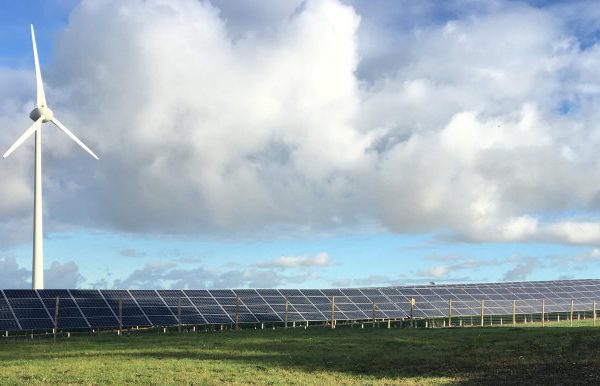
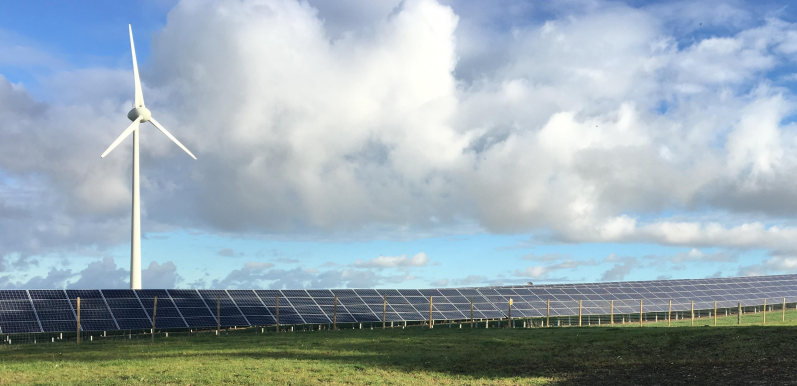
Green Cat Renewables Technical Services team conducts Due Diligence reviews on the technical merits of small, medium and large renewable technology projects to help inform investors and lenders.
Our team of analysts and engineers provides impartial technical reviews to identify project risks to investors. Reviews encompass project design and performance, planning obligations, grid requirements, project contracts, warranty compliance, site conditions, and technical CAPEX & OPEX inputs.
Projects are situated across the UK and internationally and feature a wide range of sizes.
Assets include 1.50kW domestic wind turbines up to 69MW wind farms, 2kWP domestic solar schemes up to 100MWp solar farms, and hydro schemes up to 2MW. Project designs also feature hybrid technologies (including G100 connections), storage solutions, and private-wire connections.
Evaluations are undertaken at all stages, from pre-construction funding to operational refinancing and acquisition.
Our client-driven and proportionate approach ensures key data is appraised while minimising transaction due diligence costs and turnaround times.
Site visits are conducted during: predevelopment stage to verify contextual surroundings that may affect construction and long term performance; key stages in the construction of the development to document and confirm the quality of the works; and, operational stages to inspect the ‘as-built’ design and condition.
For energy yield assessments (EYAs), measured environmental data or historical energy data from operational assets is processed and prepared for correlation with off-site long term reference climatic data.
Assessment includes enquiry into downtime periods, performance issues, and environmentally impacted generation periods. Long term P50 yields are derived based on measured site data and historical climate, accounting for technical losses.
Uncertainty analyses are undertaken to estimate the variability of long term prediction due to measurement and modelling accuracy, as well as natural variability, and forms the basis of P90 energy production estimates.


Technical advice and assessment on the delivery of small, medium and large-scale renewable technology projects.
The Technical Services team brings a wealth of experience in the review and ongoing management of wind, solar, hydro, battery, and hydrogen energy projects.
Our technical advisors have practical experience in the planning, design, analysis and engineering delivery of renewable energy projects, enabling Green Cat Renewables to provide a holistic approach to the technical analyses required by developers, funders, landowners, and other project sponsors.
Our team has undertaken wind, solar, hydro, storage, and hybrid system evaluations across the UK and internationally.
Projects range from small scale single wind turbines (1.50kW) to large scale wind farms (69MW), hydro (up to 2MW) and solar (2kWp – 100MWp). Evaluations are undertaken at all stages, from initial feasibility to snagging and construction stage site inspection service.
We are therefore able to provide project development support at all scales and stages of development.
Project Feasibility
Early stage development support, providing initial design and feasibility reviews. This is increasingly valuable to clients seeking development opportunities using multiple technologies or behind the meter solutions.
Energy Yield Assessment
For wind, solar, hydro, storage, and hybrid systems at all project stages in a cost-effective and flexible manner.
Due Dilligence
Technical reviews at all project stages for a range of leading banks, private equity investors, and public bodies. Proactive approach to working together with investors, advisors, developers and stakeholders to mitigate technical risks and facilitate financial close.
Management Services
To provide ongoing performance monitoring of operational sites, including monthly performance reporting to investor requirements, planning condition monitoring, annual and ad hoc site inspections, with project management and troubleshooting as they arise.
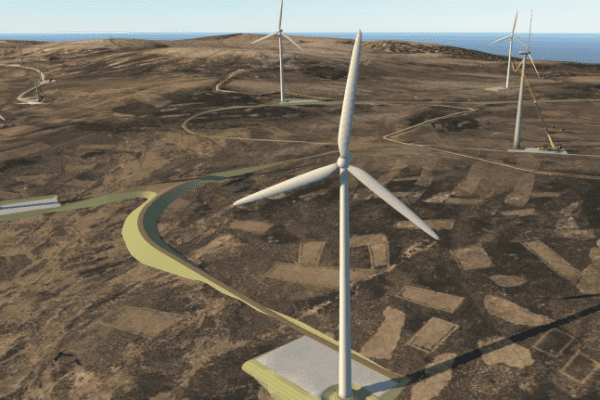
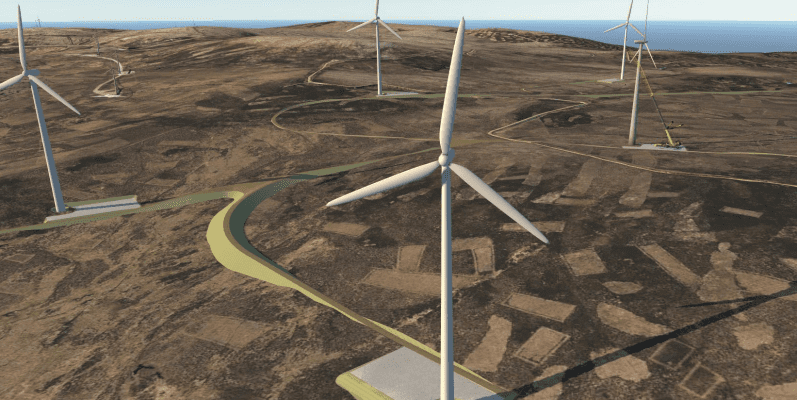
Green Cat Renewables are experienced in the designing of all infrastructure required to build and operate a wind farm all the way from concept planning stage through to operation.
Green Cat Renewables (GCR) has designed and built wind farms on rocky mountainous sites, on flat peat bogs and most variations in between with a variety of turbine suppliers, notably Enercon, EWT, Vensys, Vestas and Nordex.
GCR has a dedicated team of civil engineers, geotechnical engineers, and CAD engineers to create a complete and reliable solution for clients and contractors.
All site designs are modelled in 3D against accurate topographic data. Software such as Infraworks create 3D visualisations at the concept design stage. Then, more detailed analysis is carried out in Civil 3D software where roads and crane pads are incorporated.
GCR undertakes earthworks and materials volume analysis to optimise construction. Setting out data to be provided to contractors in 3D AutoCAD or Excel files to allow for accurate setting out on site.